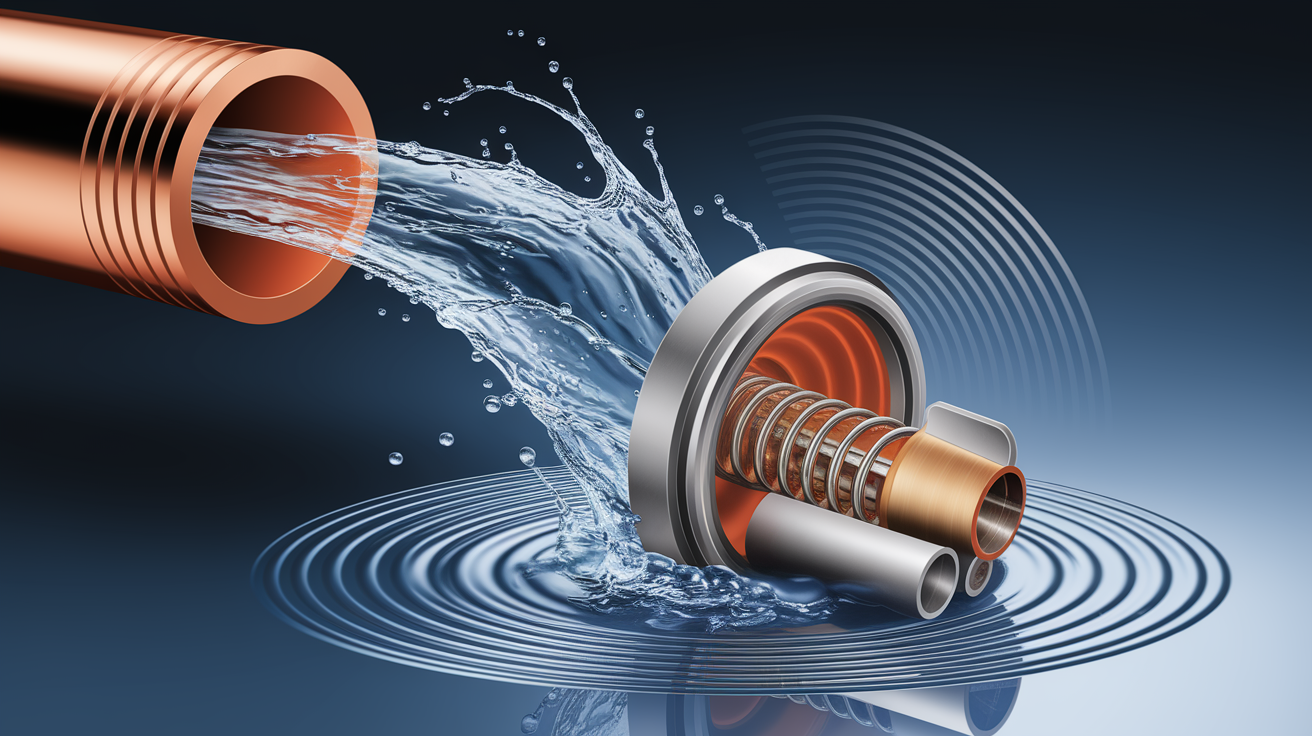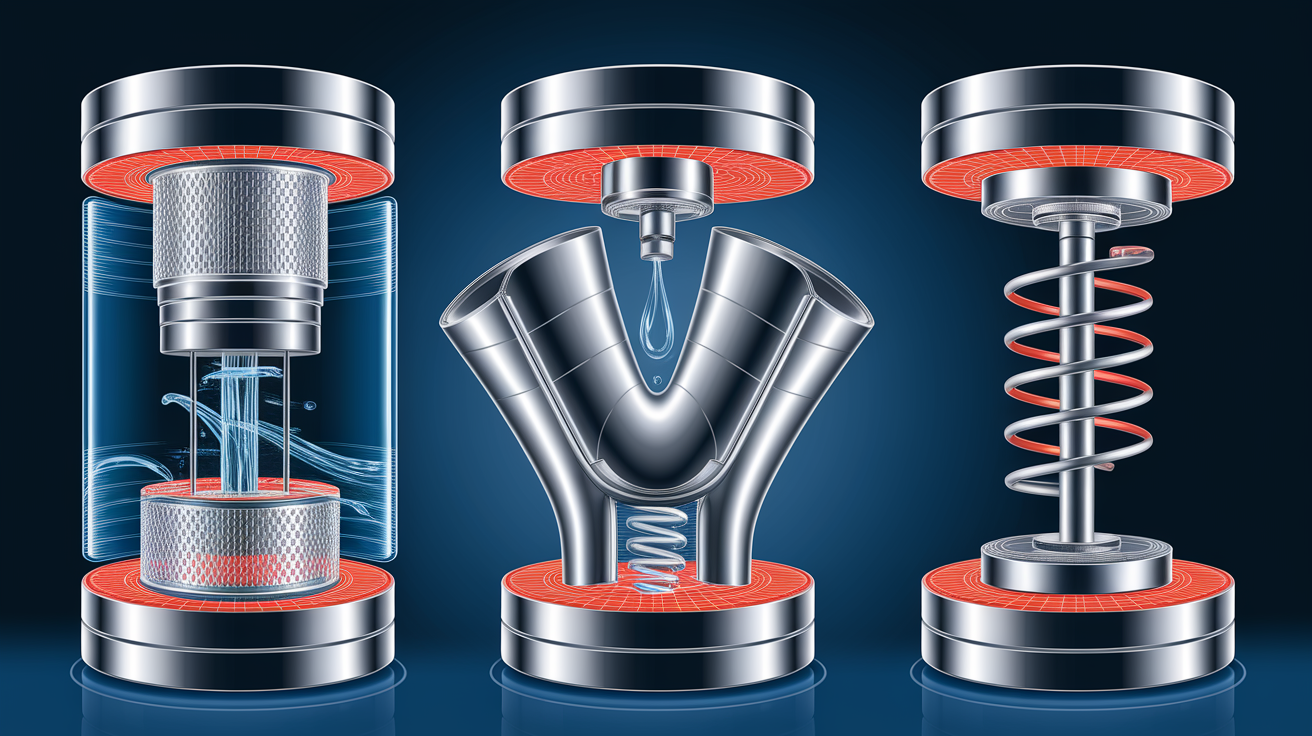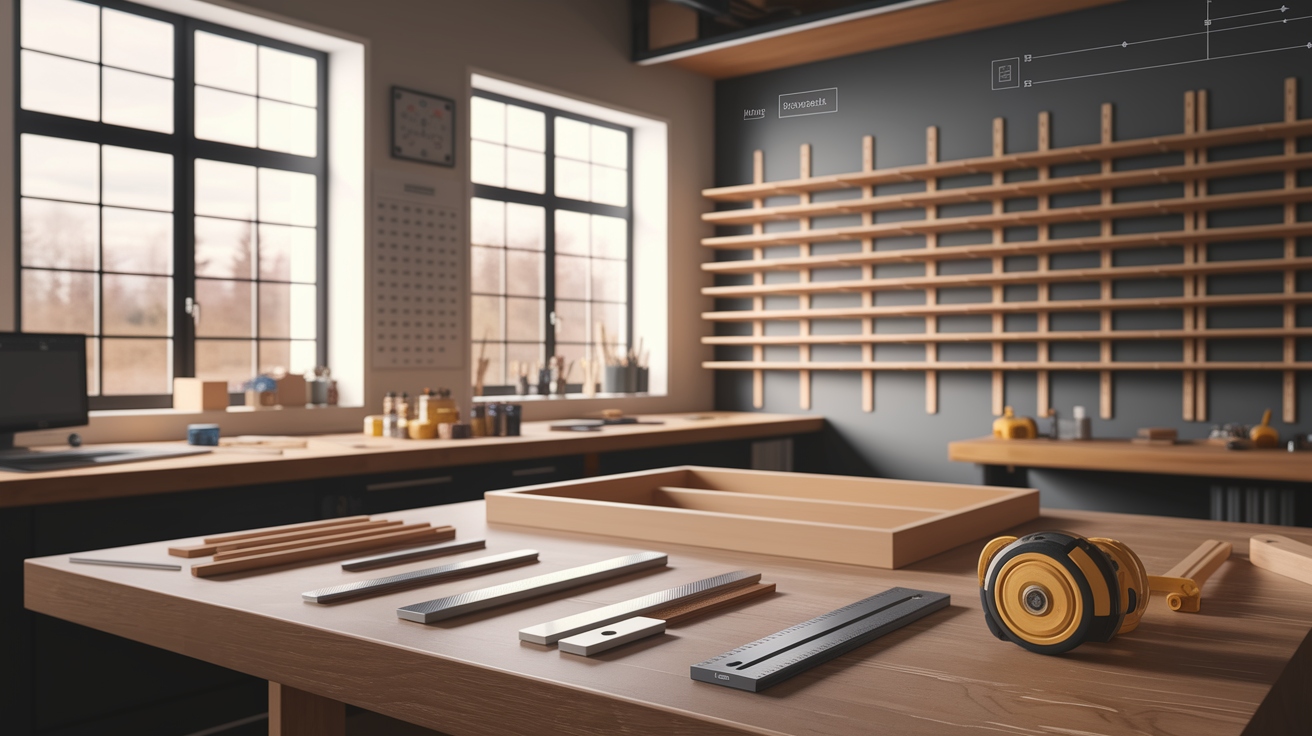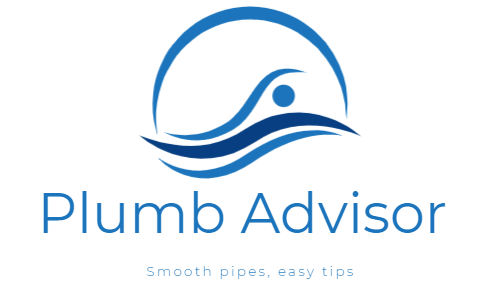Introduction – Your Pipes’ Silent Protector
That sudden, loud pipe banging noise you hear when a faucet is turned off or an appliance like your washing machine stops filling? That’s water hammer. More than just an annoyance, this hydraulic shock can wreak havoc on your home’s plumbing system. Over time, the force from these hammering sounds can lead to loosened pipe joints, leaks, and even burst pipes. But don’t worry, there’s a straightforward solution: the water hammer arrestor.

A water hammer arrestor is a small but mighty device designed to protect your water supply lines and fixtures. It’s your pipes’ silent protector, working to absorb the sudden pressure surge that causes that startling “bang.” Think of it as a shock absorber for your plumbing. These devices are typically installed on the supply lines of water-using appliances known for quick-closing valves, such as washing machines and dishwashers. According to plumbing experts, a water hammer arrestor uses a spring or a special valve to absorb the built-up water pressure that results from abrupt changes in water flow. Its operation involves momentarily closing a valve when a change in pressure or flow is detected, allowing the system pressure to equalize gently, rather than creating a damaging shock wave.
How Do I Know If I Have Water Hammer?
The most common symptom is a distinct, loud banging or hammering noise coming from your pipes immediately after a valve or fixture shuts off quickly. This could be when your washing machine finishes a fill cycle, a dishwasher changes cycles, or even when you quickly turn off a sink faucet. Sometimes, it can sound like a loud bang from your faucet when it’s shut off. If these sounds are familiar, you likely have a water hammer issue.
Can Water Hammer Damage Plumbing Pipes?
Yes, absolutely. That forceful bang is a sign that a high-pressure shock wave is traveling through your pipes. This repeated stress can lead to:
- Damaged pipe joints and connections
- Leaks at fittings and fixtures
- Damage to appliance valves
- In severe cases, burst pipes
Addressing pipe banging promptly with a water hammer arrestor can prevent costly repairs down the line. It’s a key aspect of protecting your residential plumbing. One factor that can contribute to these pressure issues is sometimes the presence of air in water pipes, though water hammer is primarily about the momentum of the water itself.
How Water Hammer Arrestors Work
The science behind a water hammer arrestor is fairly simple yet highly effective. When a valve in your plumbing system closes suddenly (like the solenoid valve in a washing machine or dishwasher), the water flowing towards it has momentum. With nowhere to go, this water crashes to a halt, creating a high-pressure shock wave that travels back through the pipe – this is the “hammer.”

A water hammer arrestor functions to absorb these shock waves. Most modern arrestors contain a sealed chamber with compressed air or gas and a piston or diaphragm. Here’s a step-by-step look:
- Water is flowing normally through the pipe to an appliance or fixture.
- The valve on the appliance or fixture closes abruptly.
- The moving water suddenly stops, causing a pressure surge (the water hammer).
- This surge enters the water hammer arrestor. Inside, the increased pressure pushes against a piston (or diaphragm).
- The piston compresses the air (or gas) in the sealed chamber, absorbing the energy of the shock wave. This piston design effectively cushions the blow.
- The pressure in the pipe system equalizes, preventing the damaging pipe banging noise and protecting your plumbing.
Some arrestors may also incorporate features described as mufflers that help in slowing down the water flow to reduce noise levels. Essentially, the arrestor provides a small, temporary cushion for the water, preventing it from crashing against pipe walls and fittings. It’s crucial to note that high overall water pressure can exacerbate water hammer; it’s often wise to check your home’s water pressure, as excessively high pressure can make the problem worse or contribute to it. Similarly, if the banging seems inconsistent, it might be related to fluctuations in your water pressure.
Types of Water Hammer Arrestors
Water hammer arrestors come in a few variations, designed to suit different applications and installation needs. Understanding the common arrestor types will help you choose the right one for your DIY project.

Piston-Type Arrestors
These are the most common type for residential plumbing. They feature a piston inside a cylinder that separates a permanently sealed chamber of air or inert gas from the water. When a pressure surge occurs, the water pushes the piston, compressing the air/gas, which absorbs the shock. The piston design is favored because it ensures that water does not remain in the arrestor, keeping it watertight and airtight for long-lasting performance. These are often called piston type water hammer arrestors or sealed pressurized chamber arrestors.
Mini Water Hammer Arrestors
These are compact versions designed for point-of-use installation, directly at the problematic fixture or appliance connection. You’ll often find mini water hammer arrestors that screw directly onto the hose bibs for washing machines or supply lines for dishwashers and icemakers. They are very DIY-friendly.
Connection Types
Water hammer arrestors are available with various connection types to integrate into different kinds of piping. Common connections include:
- MIP (Male Iron Pipe): Threaded for screwing into female fittings.
- FIP (Female Iron Pipe): Female threads for screwing onto male pipe ends.
- Sweat/Solder: For permanent connection to copper pipes.
- Push-to-Connect (e.g., PEX compatible): Allow for quick installation without solder or special tools on PEX, CPVC, or copper pipes.
- CPVC: For solvent-welding to CPVC pipes.
- Hose Thread: Specifically for appliances like washing machines.
It’s important to select an arrestor with the correct connection type for your existing plumbing. Some can be installed at various angles, offering flexibility.
When selecting a water hammer arrestor, you’ll also need to consider its size, which is often related to the pipe size and the fixture units it needs to protect. For general home use, a “Size A” arrestor is common for individual fixtures or small branch lines, while larger sizes (B, C, D, etc.) are for larger pipes or multiple fixtures, more typical in commercial plumbing or for whole-house applications if specified by a plumber or plumbing code. For specific appliances, like a washing machine water hammer arrestor or dishwasher water hammer arrestor, pre-sized units are readily available.
Installation and Placement Best Practices
Proper installation and placement are key to a water hammer arrestor’s effectiveness in stopping that annoying pipe banging. While some installations are very DIY-friendly, others, especially those requiring cutting and soldering pipes, might be best left to a professional plumber if you’re not comfortable with such tasks.

Where Should a Water Hammer Arrestor Be Installed?
The golden rule for water hammer arrestor placement is to install it as close as possible to the valve that’s causing the hammer. This ensures the shock wave is absorbed before it can travel far into your plumbing system.
- Washing Machines: This is a common culprit. Install arrestors (often sold in pairs for hot and cold) directly onto the washing machine’s supply valves or hose bibs. This is an easy DIY task: simply screw them on before attaching the machine’s hoses. Learning how to install a water hammer arrestor on a washing machine is a great first step for many DIYers.
- Dishwashers: Install on the hot water supply line, as close to the dishwasher’s inlet valve as possible.
- Toilets: Modern, fast-filling toilets can sometimes cause hammer. An arrestor can be installed on the toilet’s supply line.
- Faucets & Showers: Quick-closing single-lever faucets or some shower valves can be sources. Install the arrestor on the supply line(s) leading to the problematic fixture. Determining what size water hammer arrestor do I need for a shower depends on the specific valve and pipe setup.
- Ice Makers & Other Appliances: Any appliance with a quick-acting solenoid valve can benefit.
Regarding “Do I need a water hammer arrestor for every fixture?” – not necessarily. Focus on the fixtures or appliances where you hear the pipe banging noise. However, if you have multiple problem spots or if your home has generally high water pressure, a plumber might recommend a more comprehensive solution.
Key Installation Tips:
- Turn Off Water Supply: Always shut off the main water supply to the area you’re working on before starting any installation.
- Follow Manufacturer Instructions: Each arrestor may have specific orientation or installation requirements.
- Use Pipe Sealant/Tape: For threaded connections, use appropriate pipe dope or PTFE tape to ensure a watertight seal.
- Secure Your Pipes: This is crucial. As Oatey emphasizes, the entire water supply pipe must be securely fastened. Loose pipes can still vibrate and dissipate energy, even with an arrestor, potentially causing shaking and damage. Ensure pipes are well-strapped and supported.
- Install on Hot and Cold Lines: If the hammer occurs with both hot and cold water use (e.g., washing machine), install arrestors on both lines.
Can I Install a Water Hammer Arrestor Myself?
For many common applications, like screw-on types for washing machines, yes, installing a water hammer arrestor is a very manageable DIY project. For installations requiring cutting into pipes (copper, PEX, CPVC) and making new connections (soldering, crimping, solvent welding), you’ll need the right tools and skills. If you’re unsure, calling a qualified plumber is a wise choice. The cost to install a water hammer arrestor by a plumber can vary based on accessibility and the complexity of the installation, typically ranging from $150 to $400, including the device itself.
If you’re wondering, “Do I need a water hammer arrestor for my new dishwasher?”, it’s a good preventive measure, especially if your home has had water hammer issues before or has high water pressure.
Maintenance and Troubleshooting
The good news is that modern, sealed water hammer arrestors, particularly the piston type water hammer arrestor, are largely maintenance-free. Their sealed design prevents them from becoming waterlogged, which was an issue with older, improvised “air chamber” solutions. However, a few checks and some troubleshooting knowledge can ensure they continue to provide pipe noise reduction effectively.
Regular Maintenance (Minimal but Good Practice)
While you generally don’t need to “service” a sealed water hammer arrestor, periodic inspection is a good idea:
- Check for Leaks: Inspect the connections around the arrestor for any signs of leaks. Tighten fittings if necessary, or reapply pipe sealant if a leak persists.
- Ensure Secure Mounting: Verify that the pipe the arrestor is attached to, and the arrestor itself (if it has its own mounting), are still securely fastened. Loose pipes can undermine the arrestor’s effectiveness. Proper installation and secure pipes are crucial.
- No Debris: Typically, arrestors are designed so debris isn’t an issue, but if you’re doing major plumbing work upstream, ensure lines are flushed before putting them back into service. Regular maintenance, including keeping the system free from debris, ensures optimal performance.
Troubleshooting Noisy Pipes After Installing a Water Hammer Arrestor
What if you’ve gone through the process of installing water hammer arrestor units, but the pipe banging continues or returns? Here are a few things to consider:
- Incorrect Placement: The arrestor might be too far from the source of the hammer. Try to relocate it closer to the fast-closing valve.
- Undersized Arrestor: The arrestor might be too small for the magnitude of the shock wave. This is more common if a single small arrestor is trying to handle multiple fixtures or a very high flow rate. You might need a larger unit or additional arrestors.
- Faulty Arrestor: Though rare, an arrestor can fail (e.g., loss of its air/gas charge). If it’s an old unit or suspected to be faulty, replacement is the best option.
- Loose Pipes Elsewhere: The installed arrestor might be doing its job, but other sections of your plumbing might be inadequately secured, leading to vibration and noise. Check all pipe strapping and supports.
- High Water Pressure: Extremely high system water pressure (e.g., over 80 PSI) can overwhelm even properly installed arrestors. Consider installing a pressure-reducing valve (PRV) for your whole house if pressure is consistently high.
- Other Noises: “Can a water hammer arrestor fix all pipe noise?” No, it’s specifically for the hydraulic shock of water hammer. Other noises could be from loose pipes vibrating, expansion/contraction of hot water pipes, or issues like a whistling water heater, which require different solutions.
If you’re still troubleshooting noisy pipes after installing a water hammer arrestor and can’t pinpoint the issue, it might be time to consult a professional plumber. They can diagnose complex plumbing noise problems and ensure your entire system is functioning correctly.
As for “how to fix water hammer without installing an arrestor,” options are limited and often less effective. These include ensuring all pipes are very securely strapped (which should be done anyway), installing slower-closing valves (often not practical for appliances), or significantly lowering your home’s water pressure. However, a water hammer arrestor is generally the most direct and effective solution for true water hammer.
Conclusion – Silence Restored
That jarring pipe banging doesn’t have to be a permanent feature in your home. A water hammer arrestor is a simple, effective, and often DIY-friendly solution to silence those noisy pipes and protect your plumbing from the damaging forces of hydraulic shock. By understanding how they work, the different arrestor types available, and the best practices for installing a water hammer arrestor, you can tackle this common household annoyance with confidence.
Whether you’re dealing with a loud washing machine, a thumping dishwasher, or a banging toilet supply, adding a water hammer arrestor near the offending fixture can make a remarkable difference. You’ll not only restore peace and quiet but also safeguard your pipes, valves, and appliances from potential long-term damage. So, take control of your home’s plumbing symphony and stop the bang – your pipes (and your ears) will thank you for it!








